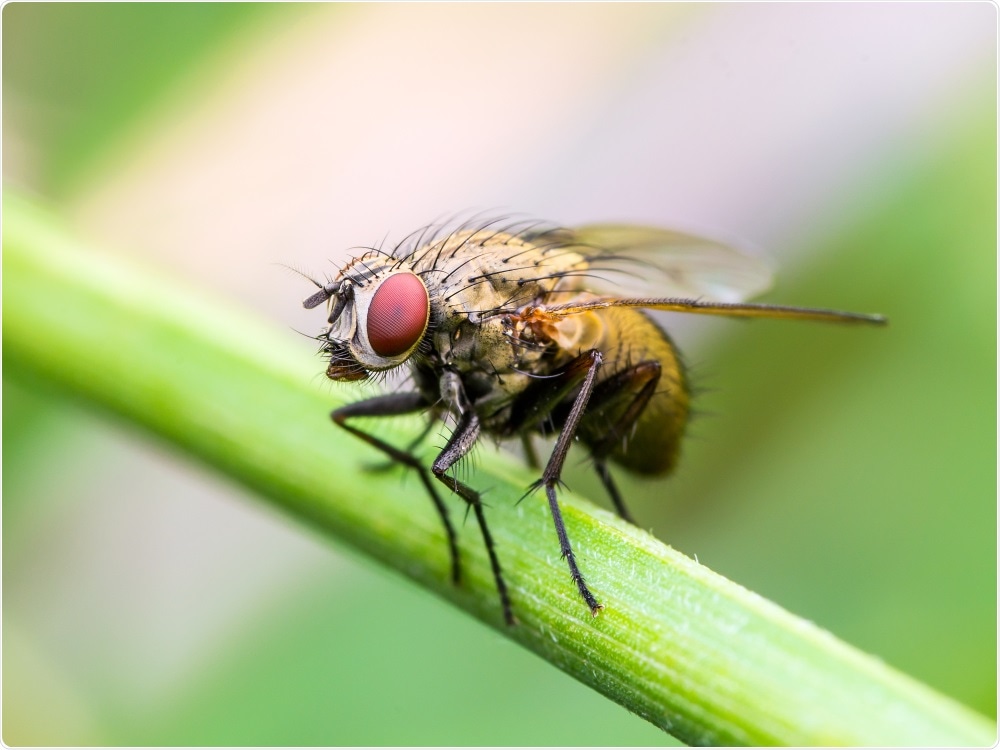Russian researchers from Skoltech, the NRC Kurchatov Institute’s Institute of Molecular Genetics, Lomonosov Moscow State University, and others have elucidated the mechanisms involved in the activation of genes in drosophila fly sex cells making the transition between two early stages in spermatozoid advancement.

Image Credit: nechaevkon/Shutterstock.com
A similar process distinguishes the body’s cells—muscles, nerves, liver, and so on—from one another and, possibly, from sick cells. The team’s observations on how the shape of DNA regulates which genes are active were published in the journal Nucleic Acids Research. These observations contribute to a better understanding of disease mechanisms and causes in terms of DNA packaging.
Except for reproductive cells, all cells in the body hold the same DNA unless there is a rare genetic condition or have had an organ transplant. The specific set of genes in the DNA that are stimulated based on the type of tissue and developmental stage is what distinguishes brain cells from, say, heart cells.
The mechanisms underlying this so-called gene regulation are still unclear, but researchers think they have a lot to do with how DNA is compiled within the nucleus of the cell.
DNA is a 2 m-long molecule crammed inside a cell nucleus, which is about one-hundredth of a millimeter across. Depending on the particular 3D configuration assumed by the DNA, regions carrying different genes are either available for activation by proteins or buried where no protein will reach them, rendering them inactive.”
Ekaterina Khrameva, Assistant Professor, Skolkovo Institute of Science and Technology
If cells regulate which genes are involved through DNA packaging, then abnormal packaging can lead to misregulation and illness. Khrameva also states, “So far, there are few diseases definitively linked to incorrect DNA packaging, but there are probably many more. It’s just that the technique used to map DNA conformation—the spatial configuration of the molecule inside the nucleus—has only been around since 2009.”
The problem is it is not enough to detect DNA conformation in a healthy cell and contrast it with that in a sick cell. To understand the mechanism behind such a disease and figure out ways of treating it, scientists have to know precisely what effect incorrect packaging has on gene functioning in each particular disorder.”
Anna Kononkova, Junior Research Scientist, Skolkovo Institute of Science and Technology
“So far, we are trying to understand the general rules that govern how DNA packaging affects gene regulation. The model we’re using is the drosophila fly, and specifically, its immature sex cell called spermatogonium as it develops into a spermatocyte, a pre-spermatozoid of sorts,” she explains.
Spermatogonia and spermatocytes are thus two different stages in the development of the same cell. In transitioning between these stages, as many as 1,000 genes are activated. This means that whatever is responsible for their regulation must kick into high gear at that time. So if changes in DNA packaging are at play, they should be detectable.”
Ekaterina Khrameva, Assistant Professor, Skolkovo Institute of Science and Technology
She further states, “Indeed, we observed that the DNA regions housing the activated genes tended to loosen up their structure. This agrees well with the intuition that they should be ‘exposed’ to facilitate the approach of activating proteins.”
The researchers also noticed that the shape of the DNA molecule altered in such a manner that the stimulated genes tended to cluster in a few specific places. This lends support to the theory that RNA synthesis—the copying of information from active genes for the production of proteins—does not occur in random locations all through the cell nucleus. Rather, it occurs at specific locations known as transcription factories.
The team used a DNA conformation analysis method called Hi-C to achieve a specified goal, which required computationally intensive experimentations. It enabled the researchers to calculate the likelihood of finding each small fragment of DNA next to each other. So, rather than producing a beautiful 3D image of how the DNA molecule is folded in the nucleus, the technique yields a slew of numbers, which are more or less equal to a qualified specialist.
The researchers have taken another step forward into recognizing gene regulation mechanisms and diseases by documenting changes in DNA packaging that occur in combination with a huge activation of genes. One of the questions that need to be researched further is whether drosophila fly genes activated in the same transcription factory have similar functionality.
Source:
Journal reference:
Ilyin, A. A., et al. (2022) Comparison of genome architecture at two stages of male germline cell differentiation in Drosophila. Nucleic Acids Research. doi.org/10.1093/nar/gkac109.